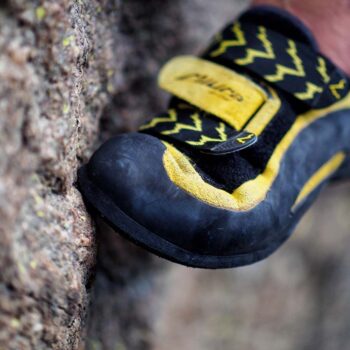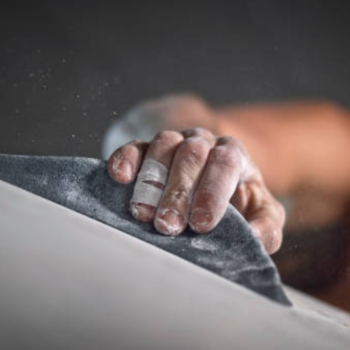How to Master Bouldering Holds
Table of Contents
What are bouldering holds?
When someone mentions bouldering holds, the first thing that probably comes to mind is the colorful plastic-like handholds or footholds that are attached to artificial climbing walls in bouldering gyms. These are called bouldering holds or climbing holds. There are various different kinds of holds, each with its own shape, size, texture, and function. Climbers use a combination of these holds to navigate from the start of a bouldering problem all the way to the top (finish).
The specific types of holds and their uses can vary depending on the style of bouldering and the specific route or problem being climbed. Here are some of the most common types of holds, their uses, and how to hold them:

Different types of bouldering holds:
Jugs/Buckets
Jugs are large, easy-to-grab holds that climbers use as a resting or recovering point. These holds are typically found on easier boulder problems and are the most beginner-friendly type of bouldering hold.
How to climb them: Jug/Buckets offer plenty of surface area to hold onto, so aim to place your entire hand or even both hands on the hold for a secure hold.
Slopers
These types of bouldering holds are characterized as smooth, rounded holds that require a lot of grip strength and body tension to use effectively. These holds are often used for balance-intensive moves.
How to climb them: When approaching a sloper, try to distribute your hand’s surface area over as much of the hold as possible. This means using your entire palm, fingers, and even your thumb to maximize contact with the sloping surface. The ultimate aim is to create as much friction as you can by pressing your hand against the hold.
Pinches
“Pinch” is exactly what you need to do in order to use pinches. Just squeeze or pinch the hold between your thumb and fingers, often in a pincer-like motion. They can be challenging because they require a combination of finger strength and proper thumb positioning to maintain a secure grip.
How to climb them: The key to holding pinches is proper thumb positioning. Place your thumb on the opposite side of your fingers, pressing it against the hold to create a stable grip. The thumb acts as the opposing force to your fingers, allowing you to generate tension and prevent the pinch from slipping.
Pockets
Pockets are small, concave holds that come in varying depths and shapes. They require correct finger placement and enough finger strength to be able to hold onto them.
Mono is a pocket that only accommodates one finger. Usually, climbers choose to use the middle finger or the ring finger for mono holds as they tend to be stronger and more stable.
How to climb them: Position your fingers inside the pocket, aligning them with the shape and orientation of the hold. The specific pocket shape will determine whether you can use a full-crimp, half-crimp, or open-handed grip. Adapt your finger placement based on the depth and size of the pocket, finding the most secure and comfortable position
Underclings
Undercling is a type of hold which is oriented in a downward direction, requiring the climber to pull themselves up and into the hold. These holds are often used for powerful moves or to change direction on a boulder problem.
How to climb them: Position your hand on the undercling hold with your fingers wrapping around the bottom or edge of the hold. Try to distribute your finger pressure evenly across the hold to create a secure grip. Place your thumb on the top of your fingers or alongside them to reinforce your grip and increase stability.
Gastons
Gastons are holds that are oriented in an outward direction, requiring the climber to pull themselves in towards the wall using a palm-upward hand position. These holds are often used for moves that require body tension and are commonly found on steep or overhanging boulder problems.
How to climb them: Position your hand on the gaston hold with your fingers or palm pressing against the edge or side of the hold. Aim to distribute the pressure evenly across your fingers or palm to create a secure grip. Depending on the size and shape of the gaston, adjust your finger placement and experiment with different hand positions to find what works best for each specific hold.
Threads
In bouldering, a thread refers to a loop-shaped handhold much like a handle.
How to climb them: Assess the gap or opening of the hold and approach it like grabbing a handle. Depending on the size and shape of the thread, you may need to use a wide grip or stacked finger placement.
Sidepulls
These handholds require the climber to pull or exert force horizontally to the side, hence their name sidepulls. They can come in various shapes and sizes, including edges, flakes, or slopers.
How to climb them: Approach the sidepull hold and assess the available gripping area. Position your hand on the hold with your fingers wrapping around the side of the hold. The thumb can either wrap around the same side or oppose the fingers, depending on the hold’s shape and your personal preference. Adjust your hand placement to find the most secure and comfortable grip.
Crimps
These are small, sharp holds that require a lot of finger strength to grip onto. They are characterized by their narrow width and typically have a small edge or lip that climbers can grasp with their fingertips. Crimps can be used for both hands and feet and are often found on more difficult boulder problems. There are different types of crimps: full crimp, half crimp, and open hand.
Crimp holds are a subject all on their own, so for a more in-depth look at how to climb crimps, check out Crimp Holds: How to Master Bouldering Holds.
These are some of the common bouldering holds you may encounter while climbing. Each hold requires specific techniques, strength, and body positioning to use effectively. It’s important to practice and don’t be afraid to find out what works for you. Happy Climbing!
If you are a beginner and you want to see first-hand how to hold these various bouldering holds, then we recommend this video, Climbing Handholds 101.
Want to learn more about bouldering, check out Bouldering: The Definitive Guide



